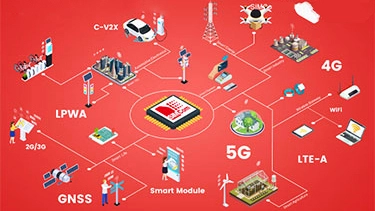Two keys to success in Tablet PC design
Rising interest in consumer and user-generated mobile video – coupled
with growing demand for higher resolution – is creating a challenge for
tablet design. Devices will need to handle large amounts of data
quickly in order to satisfy consumer expectations. Two keys to meeting
this need are enhanced USB connectivity and off-loading data tasks from
the CPU.
Video is clearly emerging as a critical application for
mobile devices such as tablet PCs. According to networking giant Cisco
Systems, 40% of the mobile data bandwidth consumed in 2010 carried
video. Further, the company expects that to grow to more than two-thirds
of all mobile traffic by 2014.
Much of this traffic is
user-generated. YouTube alone is responsible for nearly one-fifth of
mobile data traffic. Streaming of consumer or copyrighted content such
as mobile television and movies are another source. In addition, users
are increasingly downloading full movies for off-line playback onto
their tablet PCs.
Increases in video resolution are compounding
this growing demand for video data bandwidth. Traditional VGA (640x480)
resolution is already giving way to 720p for mobile devices. Tablets,
with their larger display panels, will soon need to deliver full 1080p
high definition video.
A second critical need for tablet devices
is enhanced connectivity. Externally, consumers want to be able to link
with home PCs for media downloading and file synchronization. They also
want the option of adding keyboards, pointing devices, flash drives,
memory cards, and data modems externally. Internally, developers need to
provide the applications processor with connections to data ports,
multiple radio modems for compatibility with various cellular and data
networks, internal flash memory mass storage, and potentially many other
peripheral devices.
The importance of video in mobile devices
requires that this connectivity have as high a performance as possible. A
movie download from a home PC or a WiFi network to a tablet, for
instance, requires the transfer of 2 GB for standard definition and as
much as 4 GB for a high-definition movie. Consumers have limited
patience, so the faster a tablet can complete this transfer the user
satisfaction. Users would also prefer to be able to use the tablet for
other purposes during the transfer.
USB to the rescue
One
key to addressing the video and connectivity needs of tablet PCs is
effective leveraging of the Universal Serial Bus (USB). For the external
connection, a dual-mode controller would allow the tablet to connect to
peripheral devices as a host or to a PC as a device. Internally, a USB
hub can serve many of the applications processor’s connectivity needs.
USB-based controller IP is widely available for flash disks, data cards,
and radio modems, for instance, eliminating the need for the processor
to provide separate connections or handle flash and modem interface
protocols in software.
USB is particularly convenient as an
interface to storage or peripherals handling video information. One of
the approved data classes for USB transactions is the Media Transfer
Protocol (MTP), which allows the USB link to support data transfers on a
file basis. The traditional USB mass storage device class (MSC) works
with fixed blocks, which may not be a match to the logical file size.
Further, MSC provides access to storage on an undifferentiated bulk
basis. In practice this means that the target device is under the host
processor’s absolute control for as long as the device is mounted and
the device cannot modify any of its contents without risking data
corruption.
The MTP, on the other hand, works on a logical file
basis. The USB host shares access to the target device’s file system,
allowing the target to continue working with the files the host is not
using. This allows a storage device to be involved in multiple
operations, such as giving the user access to stored documents while the
system is downloading a video file to memory. The MTP can also be run
over TCP/IP and Bluetooth, allowing such file-oriented transfers to
occur over wireless connections, as well.
USB without the PHY
One
drawback of using conventional USB for is that the link is serial,
which adds considerable latency in data transfers during command
handshaking and as information moves between parallel and serial
formats. A solution to his problem is the use of the UTMI+ Low Pin
Interface (ULPI) (Figure 1) without a physical layer (PHY) component.
The PHY-less ULPI permits two devices to connect through an 8- or
12-line parallel bus while still appearing as the USB at the software
link layer.
Figure 1. The ULPI interface developed for USB allows a small
parallel bus connection between devices that behaves as
a USB connection at the software link layer.
Use of the parallel bus to connect devices eliminates the
overhead of serialization and greatly speeds handshaking between
devices. Further, because the signals use today’s low-voltage logic
levels, ULPI eliminates the need for charge pumps or voltage converters
to generate serial USB signals, reducing cost, parts count, and battery
drain. These benefits of high performance, modest signal count, and
simple connection to a wide range of peripheral device controllers are
so compelling that ULPI is even beginning to appear on many embedded
processors as an alternative to traditional wide local bus structures
for peripheral connections.
While the USB in all its forms helps
solve connectivity challenges in tablet design, though, the resulting
data flow presents a significant performance burden. High speed USB
allows transfers with a theoretical limit of 60 Mbytes/second but many
PC host processors have only about half that bandwidth in and out of
system memory. Further, the flash memory technology used in mobile
devices typically only achieves system memory bandwidths on the order of
8-10 Mbytes/second. Moreover, CPUs in mobile devices can introduce
latency in transferring data between USB and mobile flash memory if they
cannot provide a direct data path between the two.
The key to
opening this bottleneck is to offload data-intensive tasks from the
tablet processor. Providing a direct path from the USB controller to the
data card controller and using MTP, for instance, would allow the
downloading of a video file from the home PC to mass storage without
host CPU intervention - a process known as side loading. This
sideloading eliminates the need to first write to and then read from
system memory during the file transfer. Sideloading thus both speeds the
file transfer and frees the system processor to perform other tasks.

















